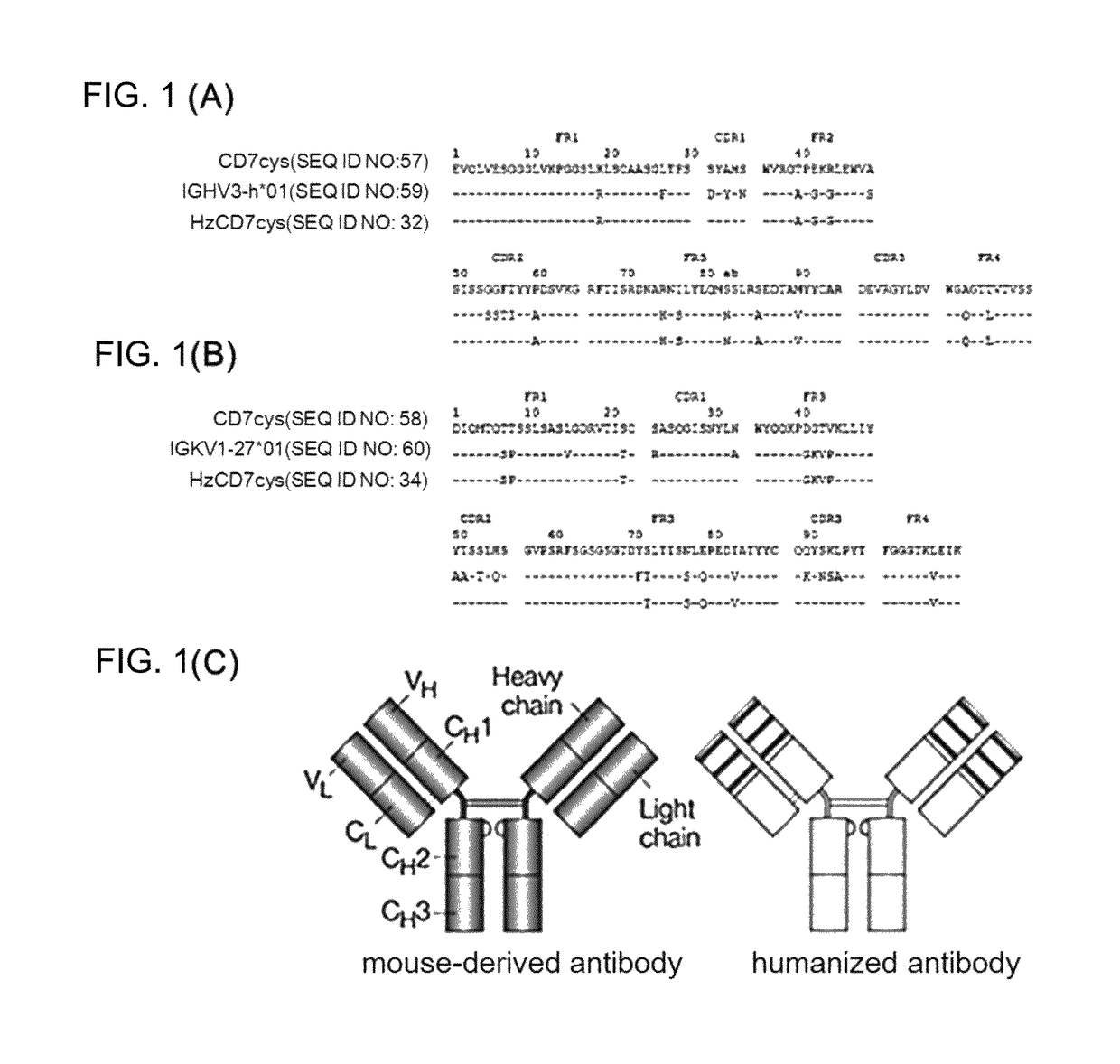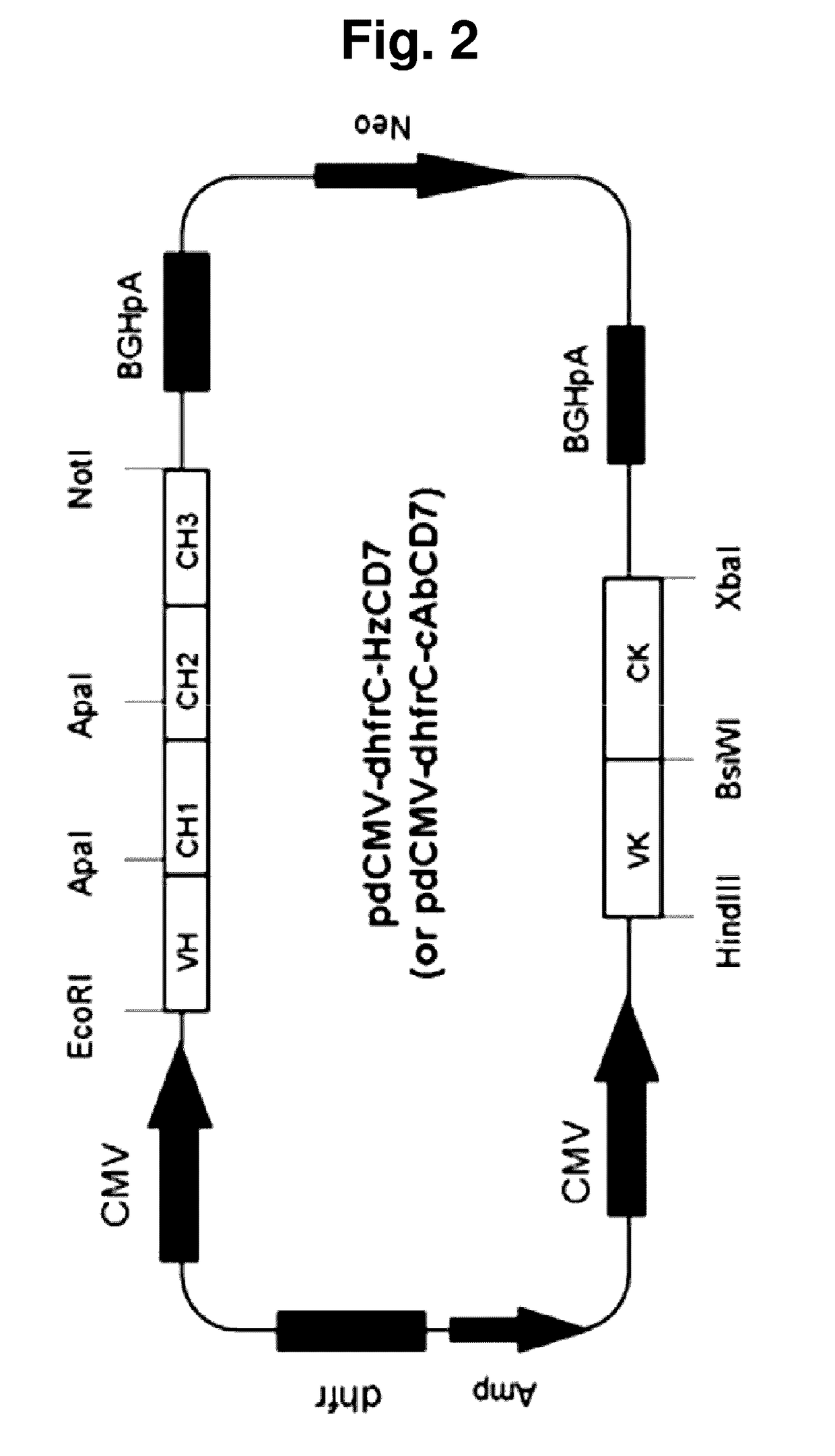T-cell-specific humanized single fragment antibody delivery vehicle
a humanized, single-fibre technology, applied in the direction of immunoglobulins, antibody medical ingredients, peptides, etc., can solve the problems of lowering the efficiency of delivering sirna gene or immune response modulating protein to t cells, and aging-related diseases with an increasing incidence are emerging as a new social problem, so as to achieve the effect of reducing antigenicity
- Summary
- Abstract
- Description
- Claims
- Application Information
AI Technical Summary
Benefits of technology
Problems solved by technology
Method used
Image
Examples
example 1
Preparation of Humanized scFv to Human CD7 (HzscFvCD7)
[0075] Design of HzscFvCD7
[0076]As a result of searching human germ cell lines having the highest amino acid sequence identity to a mouse-derived antibody to human CD7 (CD7cys) through the IMGT site (img.org), (1)the heavy chain sequence of the mouse-derived antibody to human CD7 (CD7cys) was most similar to IGHV3-h*01(P) of the human heavy chain sequence, and (2) the light chain sequence of the mouse-derived antibody to human CD7 (CD7cys) was most similar to IGKV1-27*01 of the human light chain sequence. Based on the above results, humanized scFv to CD7 (HzscFvCD7) was designed by replacing framework (FR) regions with human heavy chain or light chain sequence while conserving CDRs (in CDR of the antibody, the most variable region is referred to as hyper variable (HV) region, and a region of which the amino acid sequence is less changed and stable is referred to as FR) (FIG. 1). However, when designing the HzscFvCD7, portions of ...
example 2
Expression and Purification of humanized scFv to Human CD7 (HzscFvCD7)
[0103]E. coli strain BL21 was transformed with the HzscfvCD7-pET21b constructed in example to obtain BL21 single colony. The BL21 single colony was inoculated in LB liquid media containing ampicillin, and then cultured in a shaking incubator at 37° C. The absorbance thereof was measured at O.D. 600 nm using a spectrophotometer, and the BL21 single colony was cultured until the O.D. value reached 0.6 to 0.8, followed by the addition of IPTG, and then cultured at 26° C. overnight. The bacteria pellets obtained by 4000×g centrifugation at 4° C. for 10 minutes were sonicated using a sonicator while the lysis buffer was added thereto, and again centrifuged at 4000×g for 40 minutes at 4° C. to separate a supernatant. After that, humanized scFv to human CD7 (HzscFvCD7) was purified using FPLC.
[0104]The purified HzscFvCD7 was subjected to dialysis in DPBS of pH 7.4, and then concentrated using a concentration column. The...
example 3
Preparation of carrier using specificity of HzscFvCD7
[0106] Conjugation of HzscFvCD7 and Poly Oligo-9-Arginine
[0107]As one method for using HzscFvCD7 as a carrier for siRNA, poly oligo-9-Arginine (hereinafter, referred to as 9R) capable of binding to siRNA was conjugated to HzscFvCD7.
[0108]More specifically, the N-terminal of HzscFvCD7 was inactivated with sulfo-NHS-acetate, and then unreacted sulfo-NHS-acetate was removed using the dialysis membrane. Then, the primary amine group (N-terminal) of 9R was disulfide-bonded to Cys of the C-terminal of HzscFvCD7 through the NHS-EDC reaction, thereby preparing a carrier for siRNA having a structure shown in FIG. 5(A).
[0109]Then, it was confirmed through MALDI-TOF whether HzscFvCD7 bound to 9R. As a result, it was verified that HzscFvCD7 chemically bound to 9R by about 90% or more (FIG. 5(B)).
[0110] Conjugation of HzscFvCD7 and Liposome
[0111]The liposome was prepared to have the following composition, and then used to deliver siRNA.
[0112]H...
PUM
| Property | Measurement | Unit |
|---|---|---|
| pH | aaaaa | aaaaa |
| mass | aaaaa | aaaaa |
| cell adhesion | aaaaa | aaaaa |
Abstract
Description
Claims
Application Information
 Login to View More
Login to View More - R&D
- Intellectual Property
- Life Sciences
- Materials
- Tech Scout
- Unparalleled Data Quality
- Higher Quality Content
- 60% Fewer Hallucinations
Browse by: Latest US Patents, China's latest patents, Technical Efficacy Thesaurus, Application Domain, Technology Topic, Popular Technical Reports.
© 2025 PatSnap. All rights reserved.Legal|Privacy policy|Modern Slavery Act Transparency Statement|Sitemap|About US| Contact US: help@patsnap.com



